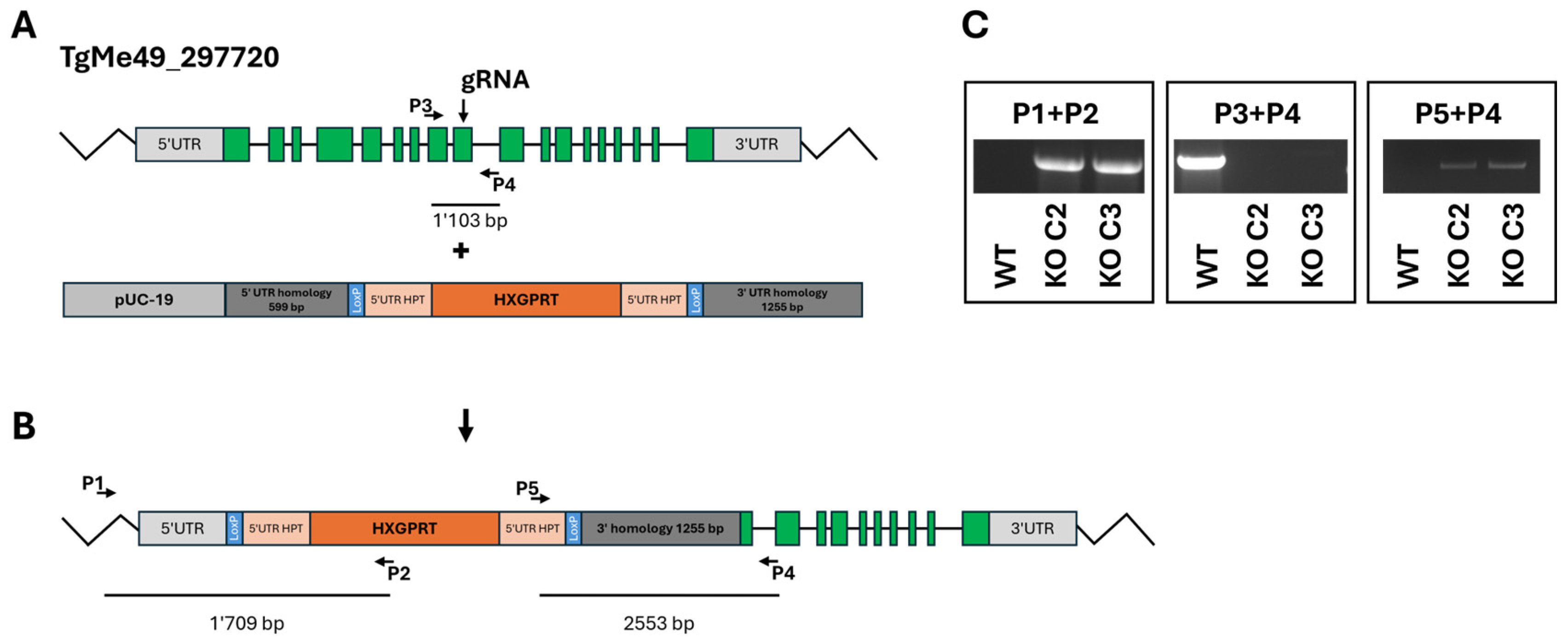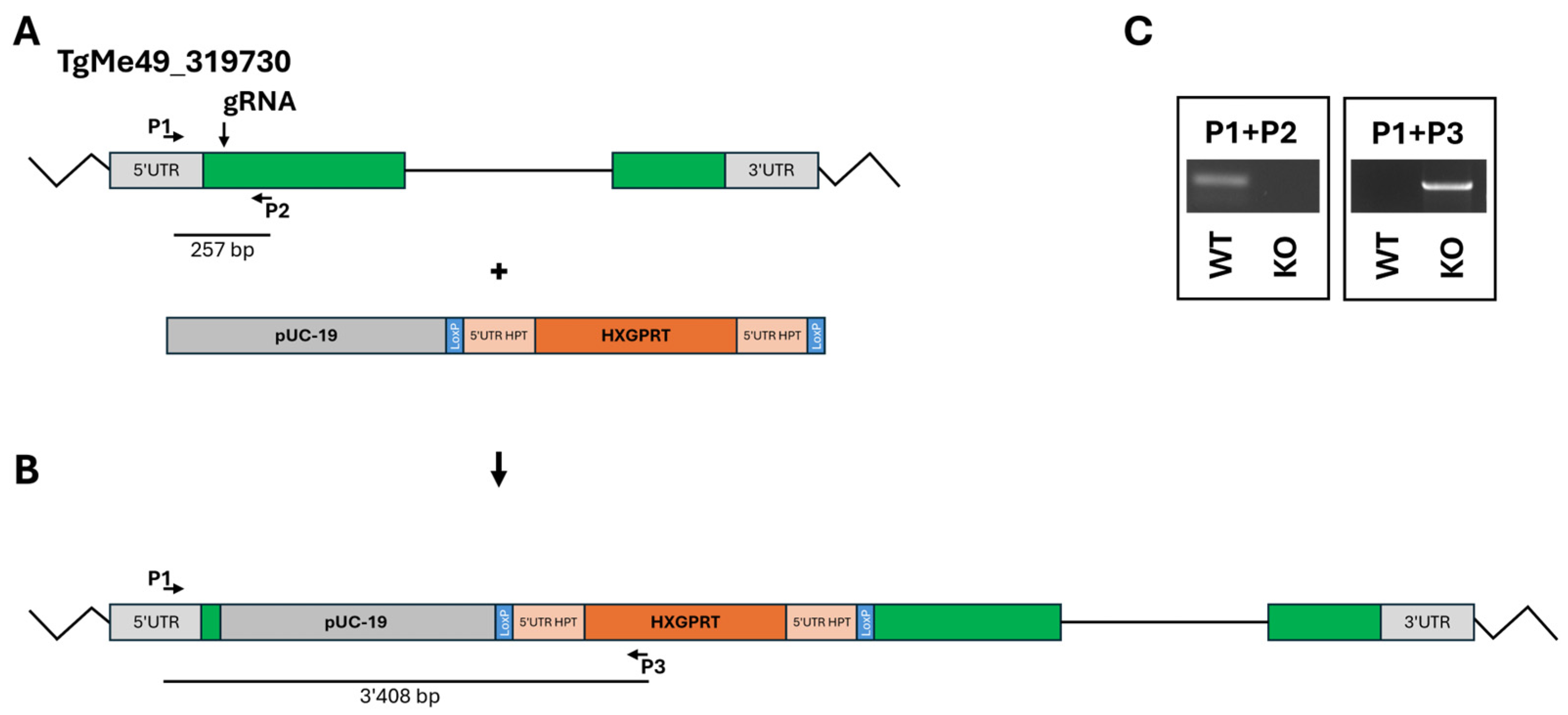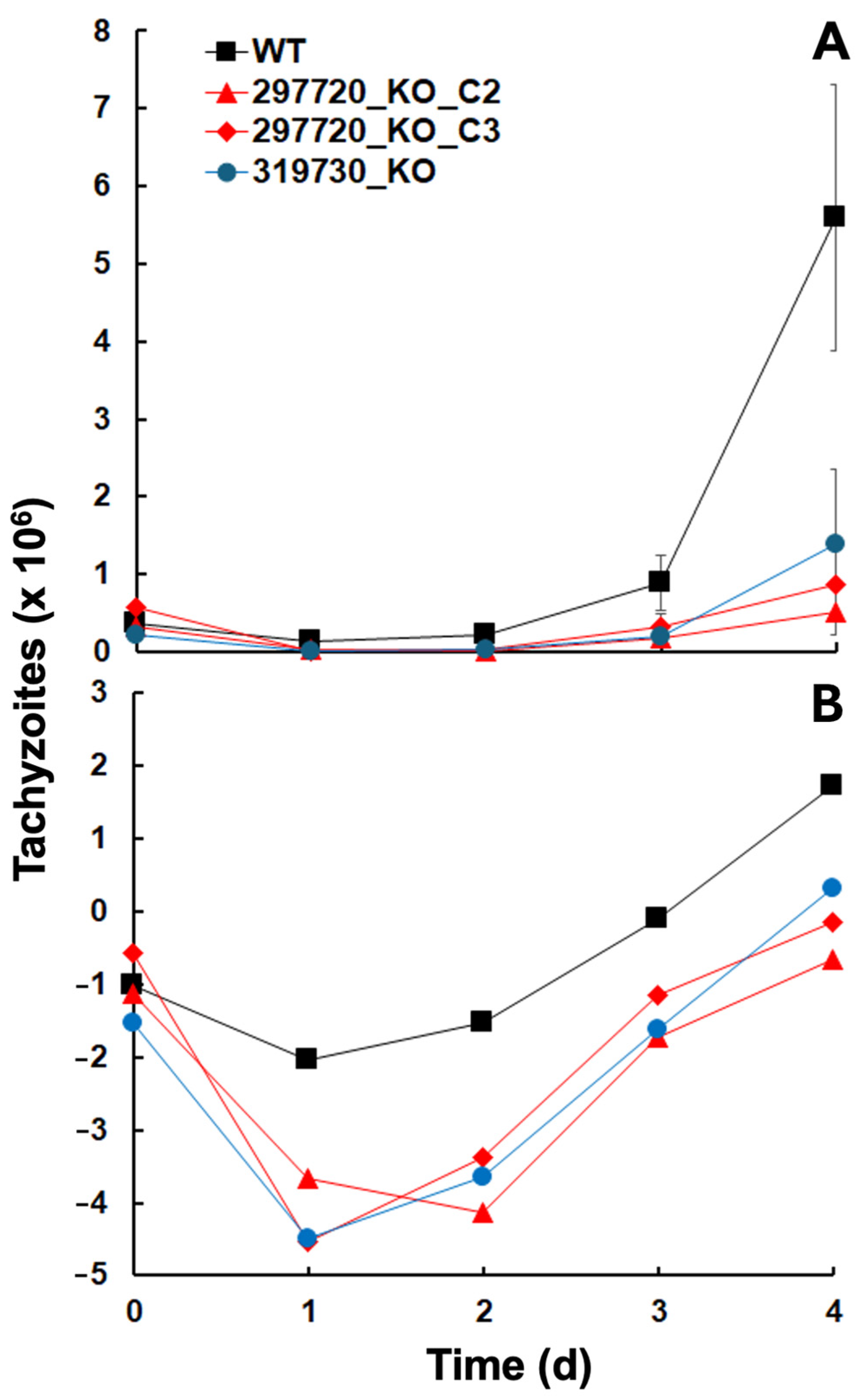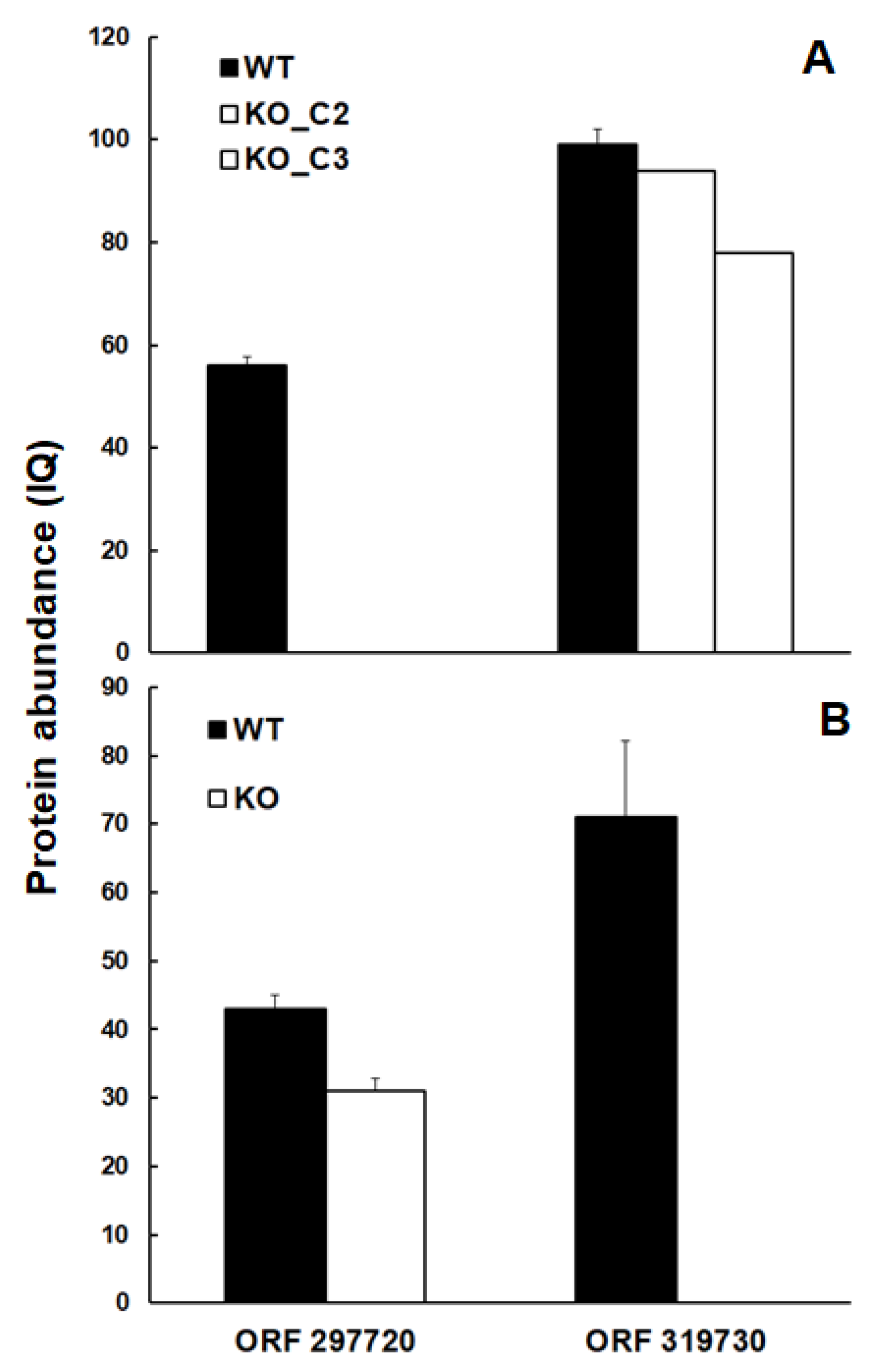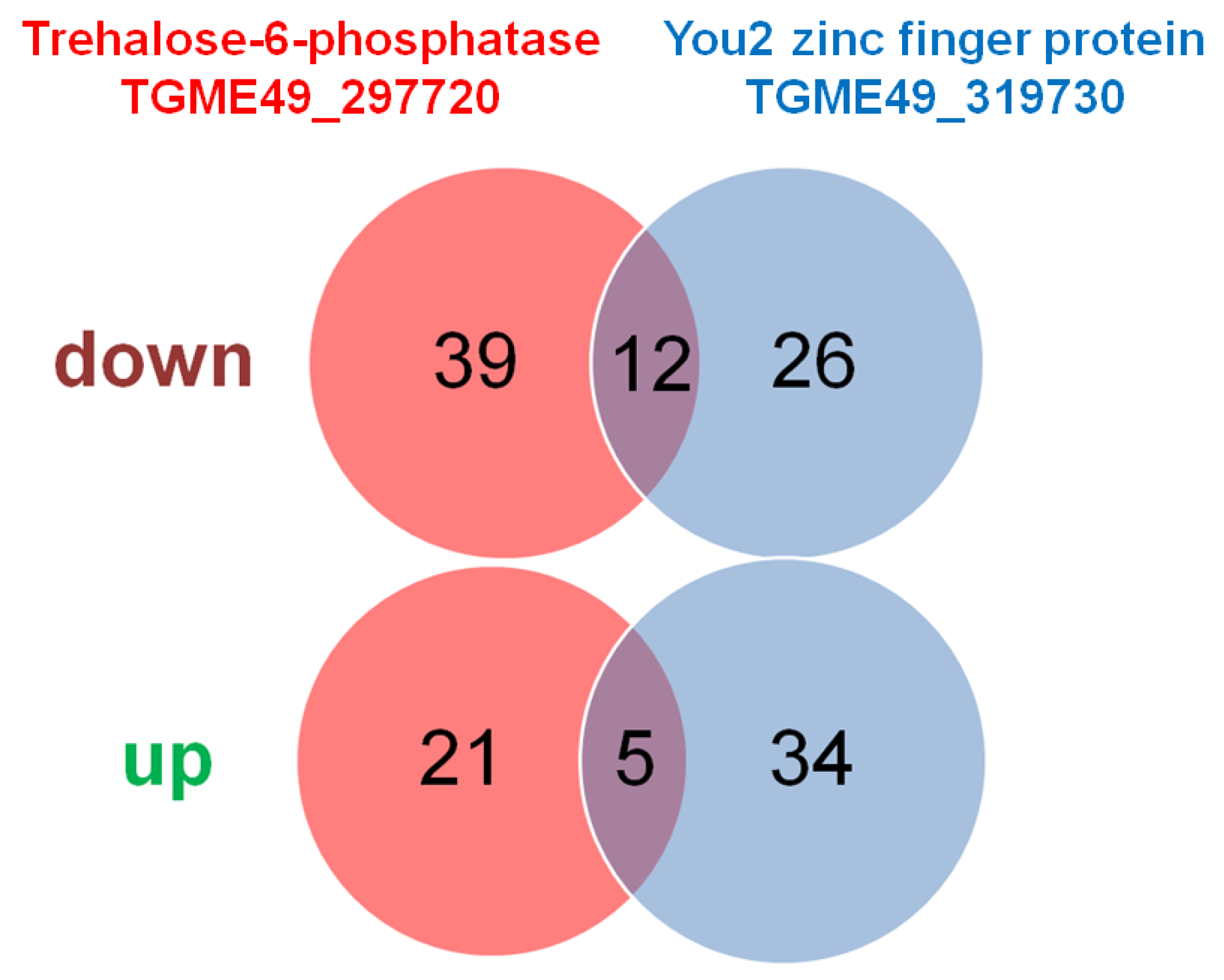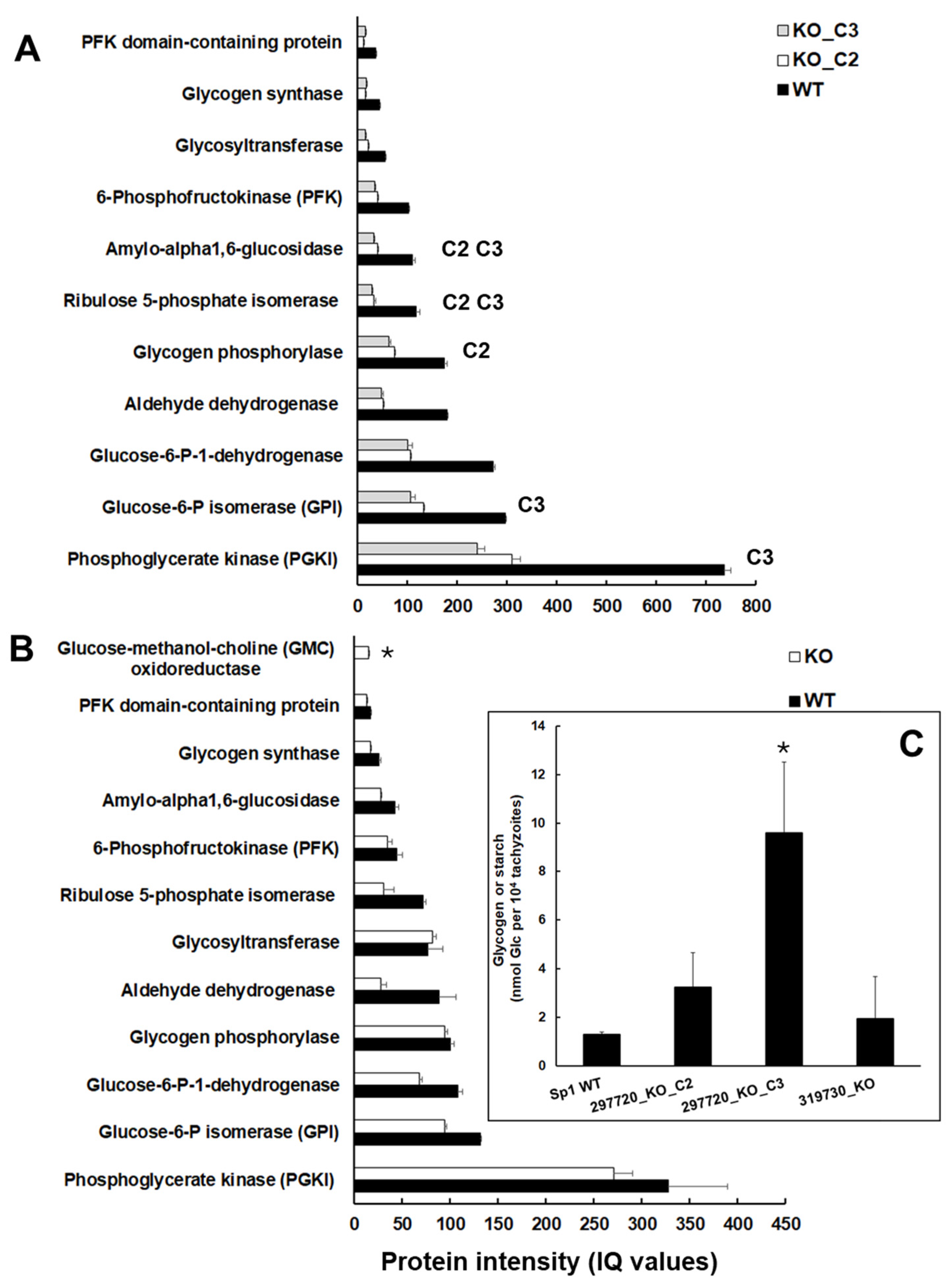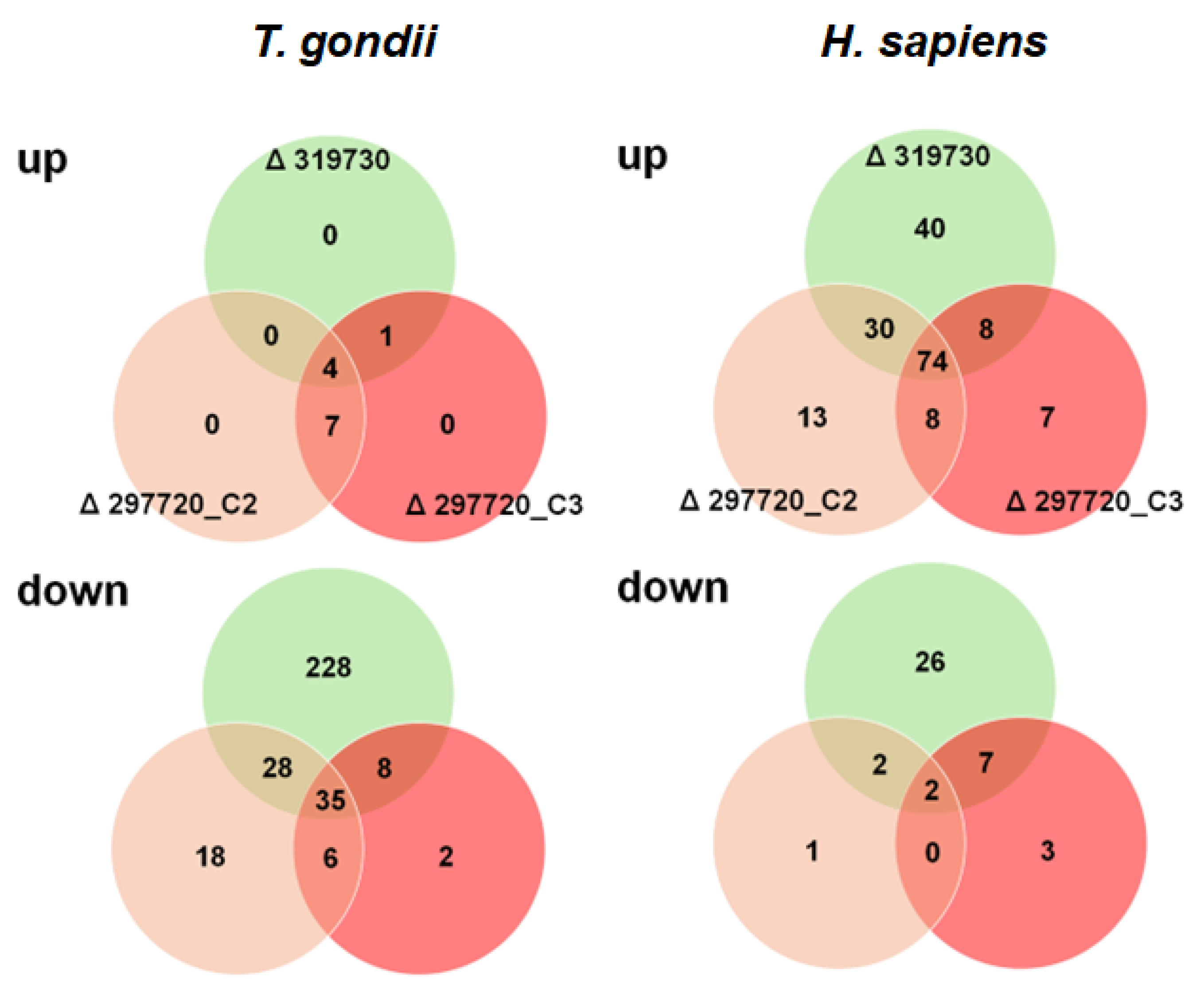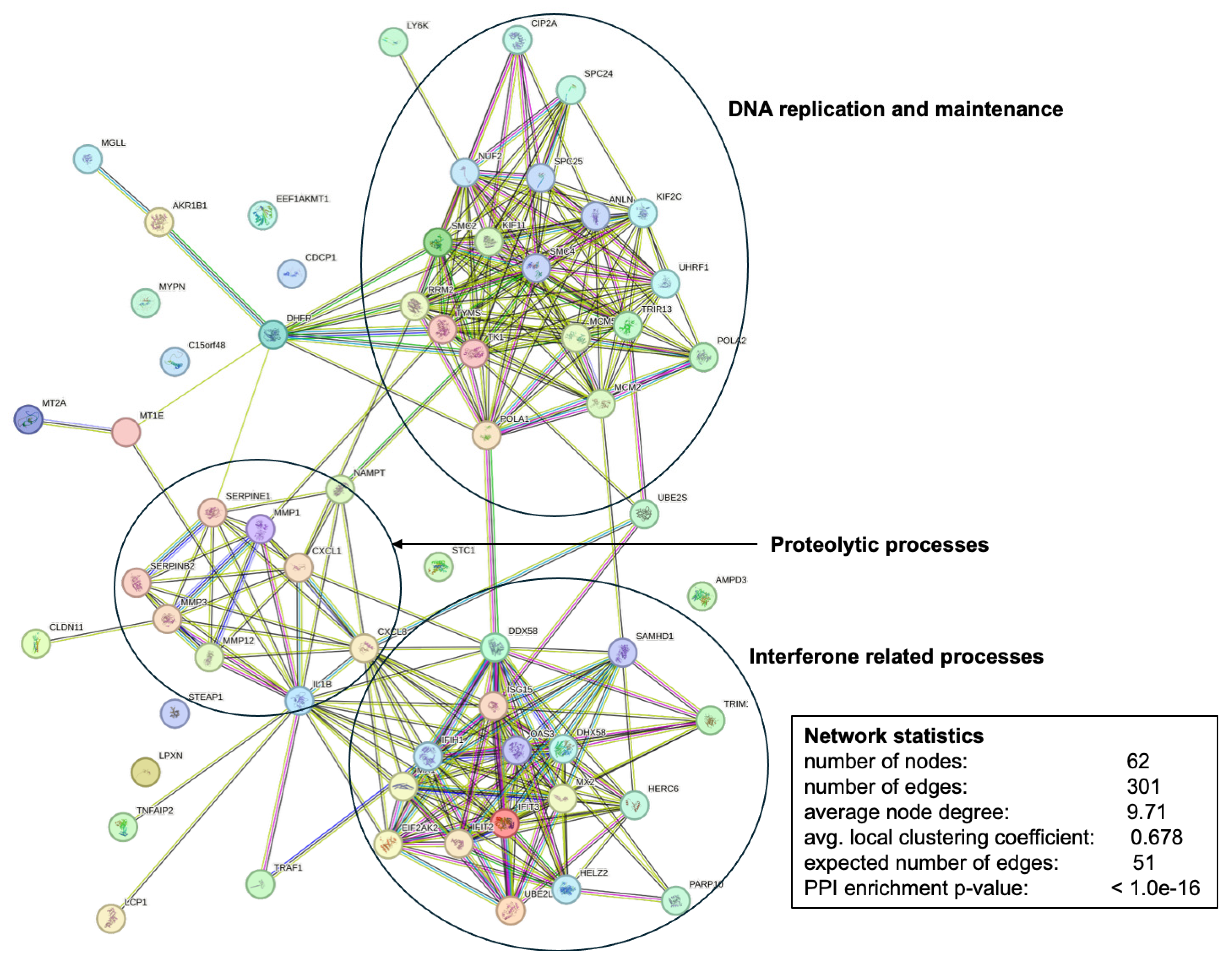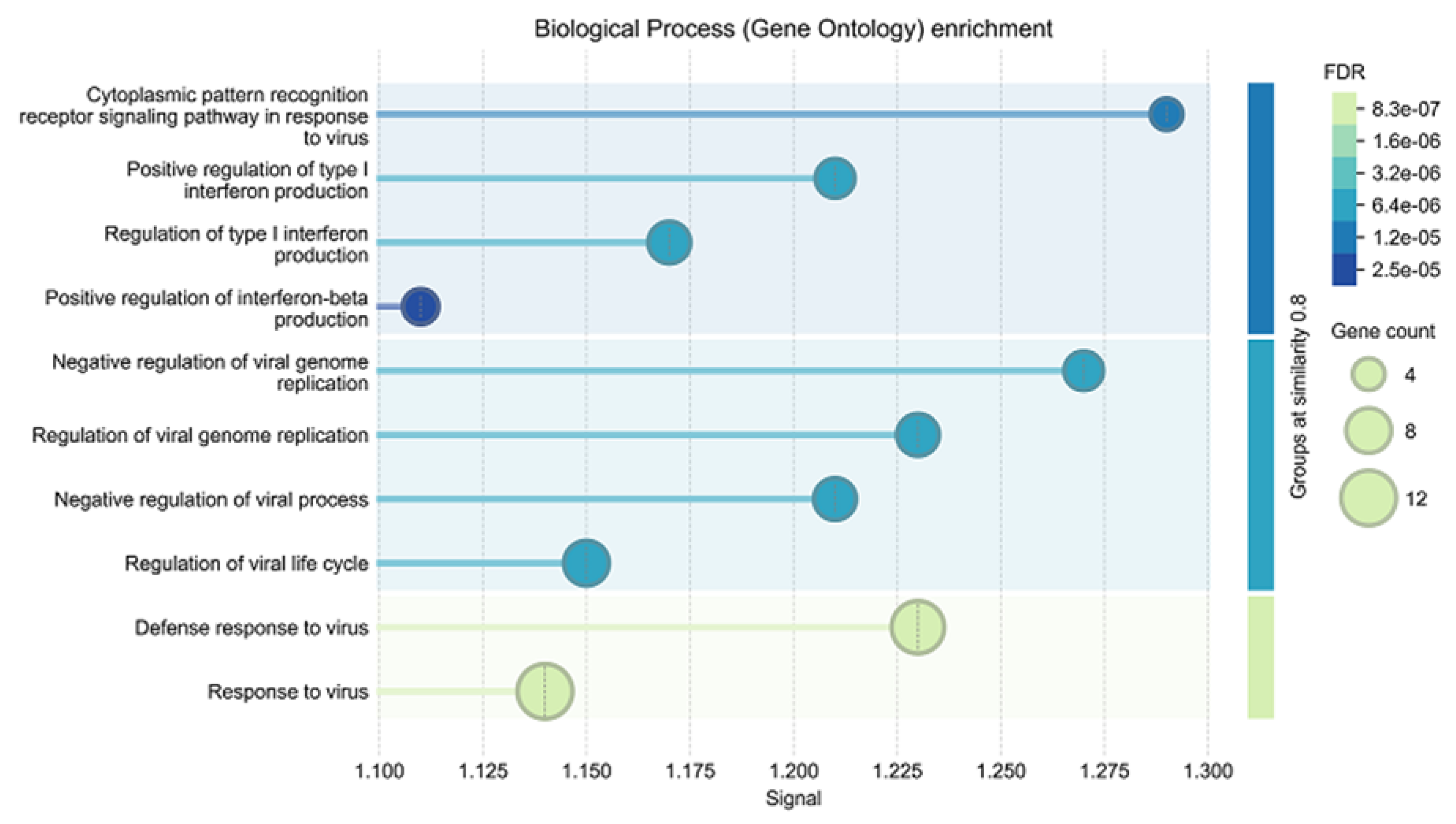1. Introduction
The intracellular parasite
Toxoplasma gondii (Apicomplexa, Alveolata, SAR [
1]) infects a broad range of host cells of animal and human origin. In humans, toxoplasmosis is one of the most prevalent parasitic diseases, with one-third of the human population on Earth being chronically infected [
2,
3,
4]. Consequently, it is not surprising that this protozoan parasite has become a major model system to study interaction with its host, with the investigations being facilitated by its amenity to genetic manipulation. In fact, for over three decades,
T. gondii has proven its excellence as a molecular genetic model [
5], and the genomes of
T. gondii ME49 and many other strains have been sequenced (
https://toxodb.org (accessed on 4 August 2025)). With respect to genetic manipulation, gene editing via CRISPR/Cas9 has become a major tool [
6,
7], and genome-wide screenings have allowed us to distinguish between fitness-conferring and non-conferring genes [
8].
Typical CRISPR/Cas9 studies generate knock-out (KO) or knock-in (KI) strains of selected open reading frames (ORFs) with the general hypothesis: KO of ORF X is followed by effect Y. Thus, X is functionally related to Y. However, the results obtained in KO studies can only be regarded as valid if the following prerequisites are fulfilled. (i.) The genetic modification, i.e., deletion of the ORF of interest at the correct location must be demonstrated by an appropriate method. (ii.) The transcript of the ORF of interest must be present in the corresponding wildtype and absent in the KO strains. (iii). The polypeptide encoded by the ORF of interest must be present in the wildtype but absent in the KO strains. (iv.) Unspecific effects of the genetic modification procedure must be distinguished from specific effects, e.g., by comparison with unrelated KO strains in the same genetic background and/or, if available, with different clones from the same KO population. Otherwise, a correct interpretation of the phenotypes of the KO strains cannot be realized. In most studies, points i and ii are paid attention to, whereas points iii and iv are often neglected. Despite the increasing importance of whole proteome analysis, e.g., of drug-resistant vs. susceptible strains [
9], such studies on KO strains are scarce. In a previously published article, we have shown that the KO of the major surface antigen SAG1 in
T. gondii RH is correlated with pleiotropic proteome changes, notably within the cell surface proteome [
10]. Thus, we hypothesize that knock-out effects extend beyond targeted genes to global proteomic changes, and may trigger secondary, system-wide effects beyond the intended target. Such pleiotropic outcomes can complicate data interpretation and limit the reliability of genotype–phenotype correlations
In this study, we compared strains with KOs in two unrelated ORFs. The first ORF is TGME49_297720 encoding a 1222 amino-acid trehalose-6-phosphatase homolog expressed in tachyzoites, bradyzoites, and oocysts (
https://toxodb.org; 4 August 2025). The second of which is TGME49_319730, a 149 amino-acid YOU2 C2C2 zinc finger protein homolog located in the mitochondrion (
https://toxodb.org; 4 August 2025) with unknown functions and structural similarities to the human mitochondrial inner membrane protein Tim10, identified as a major binding protein of an antiprotozoal compound [
11]. We investigated whether knock-out of these two ORFs leads to broader proteomic alterations in both parasite and host cells.
3. Discussion
When performing knock-out (KO) or knock-in studies, the fundamental paradigm consists of attributing the observed effects in the target organism to the presence or absence of the gene of interest. This approach is valid only if there are no pleiotropic effects obliterating or masking the effects of interest. Moreover, in the case of intracellular organisms such as T. gondii (or other apicomplexans), the effects on host cells should also be considered. In the present study, we show that targeted gene knock-outs in T. gondii can lead to broader consequences than the simple loss of the gene of interest. Specifically, we observed significant shifts in the expression of both parasite and host proteomes, including sets of differentially expressed proteins that were shared across independent knock-outs.
Thus, before analyzing specific effects of the respective KOs, we examine common effects of both KOs on the tachyzoite proteomes. Concerning common downregulated proteins at early stages (i.e., within host cells) and at late stages (i.e., in isolated tachyzoites) of infection in KO vs. wildtype parasites, it is striking that the six proteins identified are upregulated in bradyzoite vs. tachyzoites (ToxoDB, accessed August 2025 and [
12]). This suggests that the selection procedure following the transformation eliminates bradyzoites persisting in the untransformed wildtype from the cell population.
Only two proteins, namely GRA80 and GRA82, are upregulated in all KO vs. wildtype strains in intracellular as well as isolated tachyzoites. Both proteins are acidic and have signal peptides. Moreover, GRA80 has transmembrane domains (ToxoDB, accessed August 2025). GRA82 can be phosphorylated [
13]. Both proteins are regarded as merozoite and thus cat-specific sexual stage markers were detected in infected cat intestinal tissues, and were also expressed at enhanced levels upon KOs of two transcription factors [
14] and a F-box protein [
15], which are in turn regarded as triggers for sexual development. Since our KO genes were different from the genes tagged in these studies, our results suggest that differential upregulation of these proteins could be caused by a pleiotropic effect due to the genetic manipulation procedure rather than specific effects due to the particular KOs.
Concerning specific effects on the KO of TGME49_297720 on tachyzoite proteomes, it is striking that—besides the intended KO—only five proteins are DE both in intracellular and purified tachyzoites, and three of them are upregulated SRS proteins. In purified KO clone tachyzoites—thus harvested at a later stage of infection—the DE proteome of this KO is larger. In particular, glycogen/starch-degrading and glycolytic enzymes are less abundant than in wildtype tachyzoites and in tachyzoites of the TGME49_319730_KO, and conversely, glycogen/starch levels are higher. This is insofar interesting as the gene product of TGME49_297720, a 1222 amino-acid protein annotated as trehalose-phosphatase, is homologous to genes having both trehalose-6-P-synthase/phosphatase domains found in insects, fungi, and plants with the highest identity to the protein CEL0385.1 of the marine algae
Vitrella brassicaformis using the NCBI BLAST+ 2.17.0 server (
https://blast.ncbi.nlm.nih.gov/Blast.cgi?PAGE=Proteins, E value 0, 4 August 2025). In plants, trehalose-6-phosphate (Tre-6-P) is involved in several signaling processes including carbohydrate metabolism [
16]. Similar processes may occur in plant-related apicomplexans. We have, however, no functional evidence, that the gene product of ORF TGME49_297720 encodes a functional Tre-6-P synthase and/or phosphatase. In our hands, assays with the recombinant enzyme have failed. Substrates and products may be different from canonical Tre-6-P-synthases/phosphatases. Moreover, functional activity may depend on the phosphorylation status of the protein. In fact, phosphor–proteome analyses show that the TGME49_297720 protein has multiple phosphorylation sites [
13,
17], which may trigger the functional activity.
Concerning the ME49_319730_KO, the number of specific DE proteins is much higher in intracellular tachyzoites (228, all downregulated) than in isolated tachyzoites (60, 26 down-, 34 upregulated). The TGME49_319730 gene product is homologous to You2 C2C2 zinc finger proteins. In mammalians, these proteins are characterized as RNA-binding proteins controlling the expression of hundreds of target RNAs [
18]. If TGME49_319730 has the same function, this could explain why its absence is correlated with lower expression levels of multiple proteins at early stages of infection. However, it is unclear how its alleged mitochondrial localization fits into this picture.
The most intriguing aspect of this study is the pleiotropic effects of the genetically manipulated strains on host cells. In host cells infected with all KO strains, 74 proteins have lower expression levels than in wildtype-infected cells. Enrichment analysis suggests that these proteins are involved in antiviral defense mechanisms. This may explain the transient depression in tachyzoite numbers of these KO strains observed early after infection. It is well known that after entering a host cell,
T. gondii modulates its intracellular environment by modulating host cell gene expression and consequently host cell proteomes [
19]. The modulating agents are proteins secreted via rhoptries [
20] and dense granules [
21]. In particular, GRA16 [
22] and GRA24 [
21] are discussed as major effectors since both reach the host nucleus and trigger host gene expression. In our dataset, GRA24 is upregulated in host cells infected with both TGME49_297720 KO clones. However, these clones have the smallest effect on host cells in terms of host DE protein numbers. In this context, it would be worthwhile investigating to which extent GRA80 and GRA82 contribute to the modulation of host cell gene expression.
Coming back to points (i.) to (iv.) raised in the introduction, we see that, while demonstration of points i. and ii. is standard, the proteomic part of the KO strain analysis—thus points iii. and iv.—are critical and therefore most often neglected. Unambiguous identification of the proteins of interest in the wildtype and absence of the protein in the KO strain (point iii.) needs a stringent statistical approach, as shown in the present study in the case of TGME_297720. Whole-cell proteome analysis (point iv.) shows that pleiotropic effects on both parasite and host cell gene expression have to be taken into account if genes of interest are investigated in genetically manipulated strains. Consequently, appropriate controls including analysis of unrelated KO strains are needed to narrow down the spectrum of potential functions of the gene of interest. Otherwise, potential interpretation errors are programmed. However, a limitation of this study is the low number of KO clones that are investigated, and further proteomic studies on other KO strains should be carried out to substantiate these findings, ideally by also incorporating direct functional assays. Finally, non-deterministic proteome changes at the cellular level as a consequence of manipulation of a single protein mimic the unpredictable changes seen in ecosystems as a consequence of modifications of single abiotic or biotic factors [
23]. This is not surprising since it is well known that chaos or non-linear responses of systems to small perturbations is common to all scales of nature [
24,
25,
26].
4. Materials and Methods
4.1. Chemicals
If not stated otherwise, all chemical used were purchased from Sigma (St. Louis, MO, USA). Cell culture media and fetal bovine serum (FBS) were from Bioswisstec (Schaffhausen, Switzerland).
4.2. In Vitro Culture and Parasite Maintenance
Human foreskin fibroblasts (HFF, ATCC, PCS-201-101TM) were maintained in Dubecco’s modified Eagle medium (DMEM) supplemented with 10% heat-inactivated and filter-sterilized calf serum (FCS), and 1% Antibiotic–Antimycotic (100×) as previously described [
27]. TgShSp1 and corresponding knock-out tachyzoites were cultured as previously described [
28].
4.3. Isolation of Parasites
Parasites were cultured in flasks until shortly before host cell lysis. To harvest single tachyzoites, cultures were scraped and mechanically disrupted by passing the suspension three times through a 25-gauge needle. Lysed cells were centrifuged at 800× g for 10 min and washed three times with PBS, using the same centrifugation conditions. Intracellular parasites were isolated using the same procedure, but without the lysis step.
4.4. Generation of the Knock-Out Strains
A TgShSp1 strain deficient in HPT was generated at the Complutense University of Madrid, Spain following the same methodology previously applied to other strains [
29]. Selection of Δhpt-tachyzoites was achieved by culturing single clones in parallel with media containing mycophenolic acid (MPA) and xanthine (25 μg/mL each), and media containing 6-thioxanthine (177 μg/mL). Parasites that proliferated in 6-thioxanthine but not in MPA-xanthine media were chosen and verified via PCR.
To disrupt the gene coding for either TgME49_319730 or TgME49_297720 in the TgShSp1Δhpt background strain, a gRNA sequence targeting the gene was cloned into the pU6 vector (Addgene plasmid # 52694) using the BsaI-specific sites.
For the TgME49_319730 knock-out, this plasmid was transfected alongside the linearized pUC-HPT plasmid, which contains the HPT selection cassette flanked by two loxP sites, facilitating a potential future excision of the HPT selection cassette via Cre recombinase [
30]. The transfection mixture composed of a 5.6:1 vector-insert ratio, where 28 μg of the gRNA and 2.75 μg of the selection cassette were co-transfected. 5.1e7 parasites were electroporated using a Bio-Rad GenePulser Xcell (Biorad, Cressier, Switzerland) applying a 2 mm electroporation cuvette at the following settings: 1250 V voltage, 25 μF capacitance, and infinite resistance (ꚙ Ω).
For the TgME49_297720 knock-out, the plasmid containing the gRNA was transfected alongside the linearized pUC-HPT plasmid, containing homology parts at the 3′ and 5′ site of the 5′UTR and the 3′UTR of the TgME49_297720 gene, respectively. The plasmid for the HPT selection cassette containing the homology parts was created using the primers shown in
Table S8 to obtain the individual parts and the plasmid was created using the HiFi DNA Assembly Kit and the NEBuilder online tool (New England Biolabs, Ipswich, MA, USA) according to manufacturer’s protocol. The plasmid was amplified using
E. coli Top10. The transfection mixture composed of a 5:1 vector-insert ratio, where 35 μg of the gRNA and 4.55 μg of the selection cassette were co-transfected. 1.3 × 10
7 parasites were electroporated using the Nucleoflector 2b with the program U-033.
4.5. Growth Analysis
Tachyzoite growth assays were performed in 24-well plates seeded with HFF monolayers. Confluent HFF monolayers were inoculated with 10′000 tachyzoites per well. The parasites were allowed to grow until 0, 24, 48, 72, and 96 h post-infection before being harvested. At these points, the infected cell layers as well as tachyzoites in the medium supernatant were pelleted by centrifugation for 5 min at 1000×
g. Subsequently, DNA extraction of the pellets was performed using the NucleoSpin Rapid Lysis Kit (Machery-Nagel, Düren, Germany) according to the manufacturer’s instructions. The extracted samples were analyzed via diagnostic PCR targeting the 529 bp repetitive fragment of
T. gondii, and the number of tachyzoites per well was quantified by comparison with a tachyzoite standard series [
31].
4.6. Quantification of Glycogen/Starch
Glycogen/starch was quantified in isolated tachyzoites after extraction of soluble carbohydrates as described [
32,
33].
4.7. Proteomic Analysis of Isolated Tachyzoites
Protein extraction and processing for mass spectrometry was performed identically as described below for the infected host cells. The mass spectrometry analysis was performed as described earlier [
34]. The data was searched and quantified with Spectronaut (Biognosys) version 19.9.250422.62635 in the hybrid direct data-independent acquisition (DIA)+ (deep) mode against the ToxoDB-55 [
35]
T. gondii ME49-annotated proteins (with added common contaminants). Factory settings were used, including precursor qvalue cutoff = 0.01, precursor PEP cutoff = 0.2, protein qvalue cutoff (Experiment) = 0.01, protein qvalue cutoff (Run) = 0.05, and protein PEP cutoff = 0.75. Further parameters were as follows: cleavage rule = trypsin/P with maximum two missed cleavages, Carbamidomethyl (C) as fixed modification, and Acetyl (Protein N-term) and Oxidation (M) as variable modifications (maximum 5). Single hit proteins were excluded.
4.8. Proteomic Analysis of Infected Host Cells
Cell pellets were lysed in 100 μL 8 M Urea/100 mM Tris-HCl pH8, containing proteases inhibitor cocktail (Complete EDTA free, Roche, Mannheim, Germany) using 6 bursts of 10 s by a probe sonicator. Proteins were then reduced with 10 mM dithiothreitol (DTT) for 30 min at 37 C, alkylated with 50 mM Iodoacetamide for 30 min at RT in the dark, and precipitated with 5 volumes of acetone for two hours at −20 °C. Proteins were sedimented by centrifugation for 10 min at 13,000 rpm and 4 °C, and the supernatant discarded; the pellet was air dried for 15 min. Proteins were reconstituted in 30 μL 8 M Urea/50 mM Tris-HCl pH8 and protein concentration was determined by Bradford assay. An aliquot corresponding to 10 μg protein was digested for 2 h at 37 °C with sequencing grade endoproteinase LysC (Promega, Madison, WI, USA) after dilution of urea to 4 M with 20 mM Tris/HCl pH 8.0, 2 mM calcium dichloride, followed by overnight at room temperature with sequencing grade trypsin (Promega) at a urea concentration of 1.6 M. Digests were acidified with TFA (1% end concentration) and 400 ng of the digests were analyzed on a nano-liquid chromatography tandem mass spectrometer system consisting of a Vanquish Neo ultra-performace liquid chromatography (UPLC) and an Orbitrap Astral (ThermoFisher Scientific, Bermen, Germany) by loading peptides onto a C18 trap-column (PepMap 100, 5 µm, 100 Å, 300 µm i.d. ×5 mm length, ThermoFisher) at 80 bar pressure using a solvent consisting of 0.05% trifluoroacetic acid (TFA) in a water/acetonitrile mixture (98:2). Peptides were then eluted in backflush mode onto a homemade C18 CSH Waters column (1.7 μm, 130 Å, 75 μm × 20 cm) using a 22 min gradient of 5% to 40% acetonitrile in water containing 0.1% formic acid, at a flow rate of 300 nL/min. Each sample was analyzed twice, first with the data-dependent acquisition (DDA) method acquiring full scan data in the orbitrap (resolution 240′000, 380–980 m/z, normalized AGC of 300%, maximum injection time of 5 ms) and fragment spectra of peptides with charge states 2–6 in the Astral analyzer (normalized HCD energy of 28%, AGC of 80%, maximum injection time of 5 ms, scan range 120–1800 m/z, precursor exclusion for 20 s). A data-independent acquisition (DIA) mode was applied with a full scan in the orbitrap every 0.6 s (resolution 240′000, 380–980 m/z, normalized AGC of 500%, maximum injection time of 5 ms) and 299 MS2 scans of 2 m/z isolation width, with a scan range of 150–2000 m/z, and normalized AGC of 500% with a maximum injection time of 3 ms, and normalized HCD energy of 28%.
The data was searched and quantified with Spectronaut (Biognosys) version 20.1.250624.92449 in the directDIA+ (deep) mode against the ToxoDB-68 TgondiiME49-annotated proteins [
35], concatenated to the UniProt [
36] human sequences (release 2025_01); common contaminants were also added. Search parameters were 10 ppm and 20 ppm MS1, respectively; MS2 mass tolerance, precursor with protein q value, and PEP cutoffs were set to 0.01. Further parameters were as follows: cleavage rule = trypsin with maximum 2 missed cleavages, Carbamidomethyl (C) as fixed modification, and Acetyl (Protein N-term) and Oxidation (M) as variable modifications (maximum 3). Single hit proteins were excluded.
4.9. Statistics
Protein groups not flagged as potential contaminants were retained for further analysis. Following Pham et al. [
37], the distribution of fragment peak areas reported by Spectronaut was inspected and the fragments with the lowest intensities, or not used for quantification, were removed. A further filtering step, relevant for the isolated tachyzoites datasets, consisted of enforcing the precursor and protein q value and PEP cutoffs of 0.01. Based on this selection, a leading protein was chosen per protein group on the basis of best coverage. The ion-based quantification (IQ) [
37] (open-sourced-based maxLFQ) was obtained with the R package iq (version 1.10.1) for each protein group after median normalization of the fragment intensities. A Top3 [
38] implementation was also provided: peptide intensities were constructed from the sum of fragment intensities and normalized by variance stabilization [
39]; a same set of Top3 peptides per protein were chosen for all samples based on the sum of intensity across samples, thereby preventing minority peptides from contributing to the intensity. Moreover, proteins with less than 2 chosen peptides in a sample were deemed as not detected in this sample.
Differential expression between two groups of replicates was calculated, provided that at minimum two identifications existed in at least one group of replicates. Missing values were imputed at protein group level for the IQ measures, and at the peptide level for the Top3 measure. If there was at most one non-zero value in the replicate group for a protein group, then the missing values were imputed by drawing random values from a Gaussian distribution of width 0.3 × sample standard deviation centered at the sample distribution mean minus 2.5 × sample standard deviation at protein level, respectively, with 2.8 × sample standard deviation at peptide level. Any remaining missing values were imputed by the Maximum Likelihood Estimation (MLE) method [
40]. Differential expression tests were performed with the moderated
t-test of the R limma package [
41]. The Benjamini and Hochberg [
42] method was then applied to correct for multiple testing. The criterion for statistically significant differential expression was that the largest accepted adjusted
p-value reaches 0.05 asymptotically for large absolute values of the log2 fold change, and tends to 0 as the absolute value of the log2 fold change approaches 1 (with a curve parameter of 0.1x overall standard deviation) as described recently [
43]. Proteins consistently significantly differentially expressed through 20 imputation cycles for both the IQ and the Top3 measures were flagged accordingly and retained as differentially expressed.
